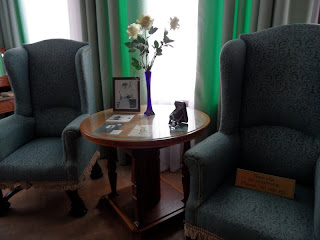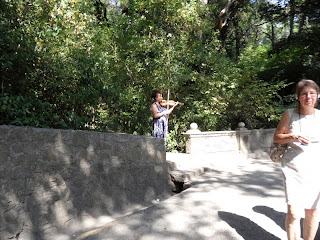Yalta’s
palaces are not just any palaces; Yalta’s palaces are where the Yalta
Conference took place. So I have
walked through halls once occupied by Stalin, Roosevelt, and Churchill. I feel cool on so many levels.
Lets start
with Livadia Palace as I did on my tour.
It was built in the beginning of the 20th century as the
summer palace of Czar Nicolai II and in 1945 played host to the main functions
of the Yalta (or Crimean as they say in the Ukraine) Conference as well as the
American delegation since FDR, being slightly crippled at the time, had to be
near the main functions in order to attend. At this conference many important decisions were laid out
including the outline of the United Nations Organization, the answer to the
“Polish Question” of vital importance to Stalin as it outlined the borders of
the democratic buffer zone between the USSR and Germany, and the role Russia
would play in the Pacific Theater after the Europe Theater had been laid to
rest. The Conference was closed
with the signing of the Declaration of Liberated Europe in alphabetical order
after Stalin, citing the fact that it would be rude for the representative from
the host country to sigh first, declined the honor. Interestingly, the palace had been pretty much destroyed by
the Germans on their way out of the Crimea so it had to be prepared for the
conference proceedings but was not fully restored until much later. The Palace is still used for
international summits, which must be seriously cool to attend given all the
history involved.
And now fun
facts! The youngest attendee of
the conference was the American ambassador to the Soviet Union who was only 35
at the time (Imagine being able to tell your grandkids about that time you were
in the same room as FDR, Stalin, and Churchill. Hell, imagine being able to tell your grandkids that you
personally knew a premier of the Soviet Union!). Also included on the guest list were the daughters of the
leaders of the conference. Stalin
was a widower at the time (which may or may not have been self imposed after
his wife was sent by “someone” to the gulag for speaking out against his
treatment of the Kulaks) so none of the delegates brought their wives
out of respect. The picture of the conference (I
didn’t totally catch the name but the title seemed to me to be pronounced Verestroika)
was taken in the central court yard on three separate chairs, so don’t piss off
your guide by asking him or her to show you the bench.
However the
history of Livadia Palace is not all Yalta Conference all the time. It was originally bought by Czar
Alexander II (he’s the cool one who freed the serfs) in 1861 but it was rebuilt
by Nicolai II later on, a czar primarily famous for being the last czar. He and his family only got to visit it
four times, for the first time in 1914 and for the last time in 1917, the year
of the revolution. Interestingly,
the palaces of the Czars are traditionally divided into “His” and “Hers”
sections of the building. We got
the opportunity to see the bedroom of the two monarchs, the Czar’s study, and
the Czarina’s boudoir. Czarina
Alexandra was a bit power hungry.
She wanted to be like the absolutists of old and consolidate power for
her son, but this sadly pissed off her people who already didn’t like her for
her associations with Rasputin and for her German heritage (in fact she was
descended from the Saxcoburgs that Queen Victoria of England was also descended
from). The final Czars asked to be
kept in Livadia Palace after the second revolution, but this request was
denied. The house in the East in
which they died was consecrated as a cathedral in their memory. The Palace was nationalized and turned
into a museum in 1925. Please
enjoy some pictures…
The
Swallow’s Nest palace was built by a German living in Russia for his Gypsy
mistress. It is a kind of symbol
of Yalta in the way that the symbol of New York City could be said to be the
Empire State Building or the Statue of Liberty (which is technically in New
Jersey). Which is to say it’s on
all the post cards. Nowadays its an Exhibition Hall and an over priced and not
very good Italian Restaurant.
Vorontsov
Palace, or The Alupka Palace, was the home of the Main Administrator or the
Crimea under the reign of Catherine the Great. Vorontsov trucked in Edward Blore, 80,000 serfs, and a
German Botanist to design and build the house and the guardens
respectively. In the palace hangs a plaque
commemorating the ten most talented serfs one of which, Роман Фуртуноѵ (I never
caught the pronunciation, but she pointed out the spelling to us), hand crafted
all the plaster decorations in the palace. Which is kind of a big deal since no room is the same as any
other room and there’s one room, which is covered in plaster flowers that
supposedly do not repeat at all.
The palace itself is a combination of Tudor and Moorish styles. I know that sounds incredibly strange,
but it actually works surprisingly well.
Count Vorontsov wanted a unique palace and he certainly got one. This palace also played host to
Churchill and his delegation during the Yalta Conference as well as to the
meetings of the Foreign Affairs ministers not attended by the Big Three. Churchill became especially fond of one
of the many lion statues that adorn the palace and surrounding parks called
“The Sleeping Lion”, saying that it looked just like him but without the
cigar.
I leave you to
enjoy the rest of the pictures. If
you’re interested in any more little stories about the Yalta Conference and
Yalta itself, please ask away in the comments. It tells me in my inbox if you comment and I check my email
very regularly.














































No comments:
Post a Comment